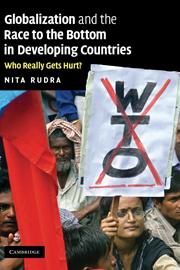Book contents
- Frontmatter
- Contents
- List of figures
- List of tables
- Preface
- 1 Introduction
- 2 The race to the bottom in developing countries
- 3 Who really gets hurt?
- 4 LDC welfare states: convergence? What are the implications?
- 5 Globalization and the protective welfare state: case study of India
- 6 Globalization and the productive welfare state: case study of South Korea
- 7 Globalization and the dual welfare state: case study of Brazil
- 8 Conclusions
- Appendix A LDC social spending
- Appendix B Assessing potential labor power
- Appendix C Additional tests for the RTB hypothesis
- Appendix D Variables in the inequality model
- Appendix E Technical notes on Gini coefficients
- Appendix F LDC Gini coefficient statistics
- Appendix G Robustness check
- Appendix H Conditional impact of trade on inequality
- Appendix I Descriptions and sources of variables
- Appendix J Cluster results minus outcome variables
- Appendix K Dendrogram for cluster analysis
- Appendix L Poverty tables
- Appendix M Social expenditures on social security, health, and education in India (percent of GDP) based on national data
- References
- Index
4 - LDC welfare states: convergence? What are the implications?
Published online by Cambridge University Press: 22 September 2009
- Frontmatter
- Contents
- List of figures
- List of tables
- Preface
- 1 Introduction
- 2 The race to the bottom in developing countries
- 3 Who really gets hurt?
- 4 LDC welfare states: convergence? What are the implications?
- 5 Globalization and the protective welfare state: case study of India
- 6 Globalization and the productive welfare state: case study of South Korea
- 7 Globalization and the dual welfare state: case study of Brazil
- 8 Conclusions
- Appendix A LDC social spending
- Appendix B Assessing potential labor power
- Appendix C Additional tests for the RTB hypothesis
- Appendix D Variables in the inequality model
- Appendix E Technical notes on Gini coefficients
- Appendix F LDC Gini coefficient statistics
- Appendix G Robustness check
- Appendix H Conditional impact of trade on inequality
- Appendix I Descriptions and sources of variables
- Appendix J Cluster results minus outcome variables
- Appendix K Dendrogram for cluster analysis
- Appendix L Poverty tables
- Appendix M Social expenditures on social security, health, and education in India (percent of GDP) based on national data
- References
- Index
Summary
Chapters 2 and 3 have presented three important findings thus far. First, in direct contrast with the nations of the OECD, governments of developing countries are sensitive to globalization and race to the bottom pressures in social security and welfare. Nevertheless, the findings in chapter 2 suggest that, paradoxically, those that comprise the bottom quintile of income distribution are not the ones directly harmed by a race to the bottom; this is mostly because social security, education, and health spending in LDCs tends to be regressive, helping mostly the middle class. The third major finding is that, while levels of health and education may not be increasing in response to globalization, public education spending is becoming more equitable. These findings overall are instrumental in illustrating the complex relationship between states and markets in the current era of globalization; domestic institutions (i.e. labor market institutions, the government–labor relationship) mediate and influence policy outcomes in a decisive and meaningful way.
Are the broader implications of these findings that the race to the bottom is leading towards convergence in lower-income economies? In other words, are all developing nations advancing towards the adoption of the “lowest common denominator” – the “neoliberal bottom” – in welfare provisions for their citizens, emphasizing minimal social welfare protections and deregulation, and investing only in those social policies that complement markets (e.g. education)?
- Type
- Chapter
- Information
- Globalization and the Race to the Bottom in Developing CountriesWho Really Gets Hurt?, pp. 75 - 107Publisher: Cambridge University PressPrint publication year: 2008

